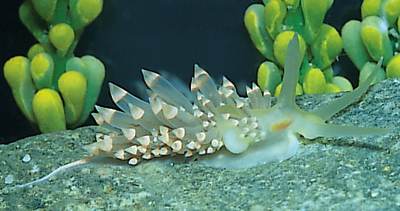
Facelina rhodopos
Yonow, 2000
Order: NUDIBRANCHIA
Suborder: AEOLIDINA
Family: Glaucidae
DISTRIBUTION
Indo-West Pacific . [Described from Red Sea. Reported in Forun from Malaysia and sthn Japan]
PHOTO
Northern Red Sea, near Quesir, 0.5m depth, Oct 1995. 15mm long preserved. Photo: Johann Hinterkircher. [Yonow, 2000: Pls 25-26]
Body, cerata and tentacles translucent yellow to orange. Body moderately narrow with wider foot. Foot much longer than body and marked with a central longitudinal peach or pink band. Cerata, in seven or eight clusters of 6-15, usually club-shaped with a terminal nipple, sometimes fusiform, are translucent with an opaque peach or pink ring distally. The tip always white.
Rhinophores, propodial tentacles and long oral tentacles pale to bright orange with white distal speckling. Rhinophores obliquely lamellated and slightly longer than the large propodial tentacles but only one third the length of the oral tentacles. Tentacle tips may be white. Head and cardiac region brighter in colour and eyes visible at base of rhinophores. Reddish brown digestive gland visible as a central extension only. Genital swelling observed under or among the first cluster of cerata.
Reference:
• Yonow, N. (2000). Red Sea Opisthobranchia 4: The orders Cephalaspidea, Anaspidea, Notasopidea and Nudibranchia: Dendronotacea and Aeolidacea. Fauna of Arabia, 18: 87-131.
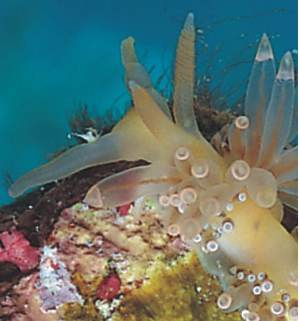
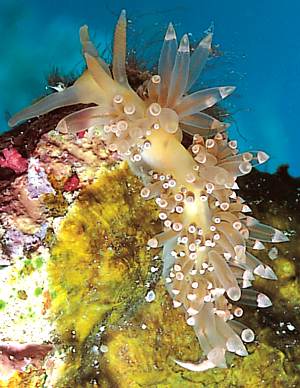
Yonow, N., 2003 (January 9) Facelina rhodopos Yonow, 2000. [In] Sea Slug Forum. Australian Museum, Sydney. Available from http://www.seaslugforum.net/find/facerhod
Related messages
Facelina rhodopos from Reunion Island by philibert Bidgrain
March 24, 2006
From: Philibert Bidgrain
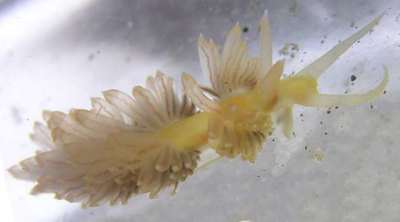
Dear Bill,
Reunion Island sea slugs.
In Reunion Island I have observed several specimens of this species from September to December in a lagoon. The maximal size is 20 mm
I think it could be specimens of Facelina rhodopos described by N.Yonow.
Locality: Etang salé, 50 cm, Reunion island, indian ocean, december 2005, lagoon. Length: 20 mm. Photographer: Philibert Bidgrain.
Best Regards
Philibert Bidgrain
http://vieoceane.free.fr/runseaslug/indexslug.htm
pbidgrain@yahoo.fr
Bidgrain, P., 2006 (Mar 24) Facelina rhodopos from Reunion Island by philibert Bidgrain. [Message in] Sea Slug Forum. Australian Museum, Sydney. Available from http://www.seaslugforum.net/find/16163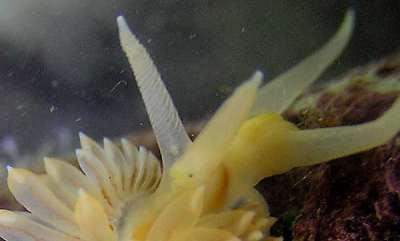
Dear Philibert,
It certainly seems to be Nathalie' Yonow's species. It's nice to get another record.
Best wishes,
Bill Rudman
Facelina rhodopos? from the Philippines
August 19, 2003
From: Erwin Köhler
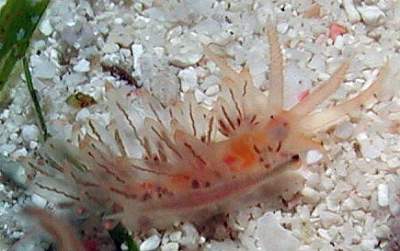
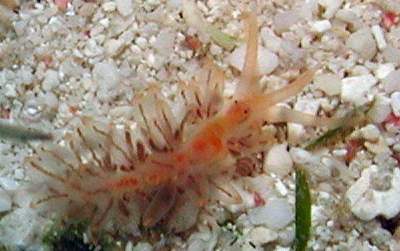
Dear Bill,
Here are 2 shots from the Philippines, Cabilao island, divesite "Lighthouse", nightdive. It looks like Facelina rhodopos, though the pink tips of the cerata are pretty poor.
data:
length 12mm
depth 6m
date 26 Feb. 2003
Cheers,
Erwin
Erwin@Philippine-Sea-Slugs.com
Köhler, E., 2003 (Aug 19) Facelina rhodopos? from the Philippines. [Message in] Sea Slug Forum. Australian Museum, Sydney. Available from http://www.seaslugforum.net/find/10764Thanks Erwin,
I am pretty sure it is Facelina rhodopos. The general colour pattern, shape and angled ridges on the rhinophores certainly fit this species.
Best wishes,
Bill Rudman
Facelina rhodopos from Marshall Ids?
January 24, 2003
From: Scott Johnson
Hi Bill,
The images of Facelina rhodopos posted recently look quite a bit like image E325-3 from the Marshall Islands on the Herviella albida page. I'll see if I can dig up some more photos of E325 that show more of the body.
Scott
johnson@kmr.ll.mit.edu
Thanks Scott,
E325-3 certainly looks like Facelina rhodopos. I look forward to seeing some more photos - a better view of the 'tail' and the rhinophores would be useful
Bill Rudman
Facelina rhodopos from the Philippines
January 22, 2003
From: Erwin Köhler
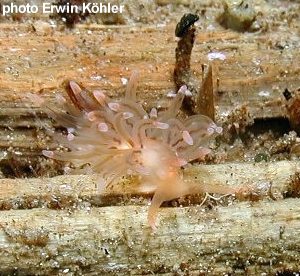
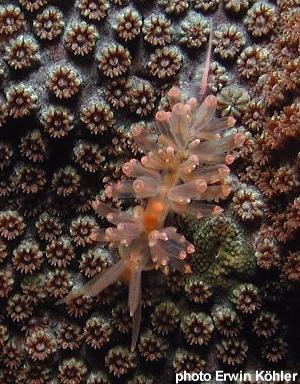
Hi Bill,
Attached are 2 shots from the Philippines, identified by David W. Behrens as Eubranchus sp. page 159 in Mr. Ono's book - now named Facelina rhodopos.
Upper Right Image:
Size: 11mm
Depth: 11m
Date: 08.March 2002
Country: Philippines
Village: Lipayo, Negros Oriental Island
Location: Dauin
Lower Right Image:
Size: 14mm
Depth: 11m
Date: 04.March 2002
Country: Philippines
Village: Lipayo, Negros Oriental Island
Location: "El Dorado" housereef, nightdive
Cheers,
Erwin
Erwin@medslugs.de
Köhler, E., 2003 (Jan 22) Facelina rhodopos from the Philippines. [Message in] Sea Slug Forum. Australian Museum, Sydney. Available from http://www.seaslugforum.net/find/8916Thanks Erwin,
It's certainly not taking long to increase its distribution from a Red Sea 'endemic' to a widepread Indo-West Pacific species.
Cheers,
Bill Rudman
Re: Facelina rhodopos from Malaysia?
January 14, 2003
From: Nishina Masayoshi
Dear Bill,
Is Facelina rhodopos the same as my animal from Malaysia?
Best Regards,
Nishina Masayoshi
nishina@wips.co.jp
Dear Nishina,
I am sure you are right. Its good to solve another 'unidentified' species and to extend its known distribution fron the Red Sea to Malaysia. If we also include the animal identified in Mr.Ono's book as Eubranchus sp. [on page 159], its distribution can be extended to Kerama Ids in southern Japan. Its colour, long 'tail', obliquely lamellate rhinophores, and ceratal shape all match Yonow's description.
Best wishes,
Bill Rudman
Facelina rhodopos from the Red Sea (1)
January 13, 2003
From: Nathalie Yonow
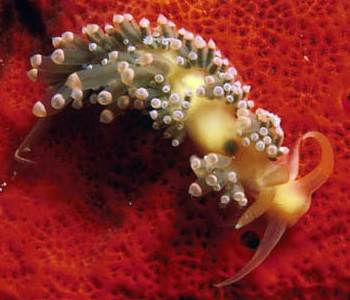
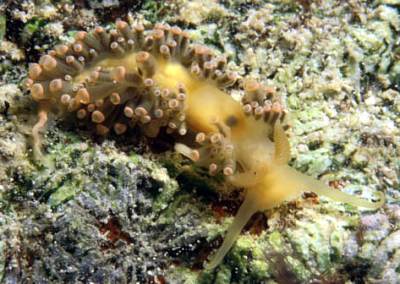
Dear Bill
Here are some photos of Facelina rhodopos, which I recently named. It doesn't appear to be too uncommon in the Red Sea. I realize the genera are somewhat complicated in aeolids. but Facelina was the best available. The species is characterised by a translucent yellow to orange body, cerata, and tentacles. There are opaque marks on the tail and sub-termainal ceratal ring which are peach to pink. The cerata are arranged in seven or eight clusters of 6 to 15 club-shaped cerata with have a terminal nipple. These two photos are by Jurgen Kuchinke, who took beautiful photos in the Red Sea. He sadly died last year.
More Red Sea things in due course!
Nathalie Yonow
N.Yonow@Swansea.ac.uk
Yonow, N., 2003 (Jan 13) Facelina rhodopos from the Red Sea (1). [Message in] Sea Slug Forum. Australian Museum, Sydney. Available from http://www.seaslugforum.net/find/8608Thanks Nathalie
Welcome to the Forum. I look forward to many more contributions.
Bill Rudman
Facelina rhodopos from Red Sea (2)
January 13, 2003
From: Nathalie Yonow

Dear Bill,
To accompany my other message, here are some more photos of Facelina rhodopos.
Data: Northern Red Sea, near Quesir, 0.5m depth, Oct 1995. 15mm long preserved.
They are by Johann Hinterkircher, who has
been wonderful in collecting and photographing material for me.
Nathalie Yonow
N.Yonow@Swansea.ac.uk


Thanks Nathalie,
Bill Rudman
Re: 'Aeolidia' helicochorda
July 2, 2001
From: Nishina Masayoshi
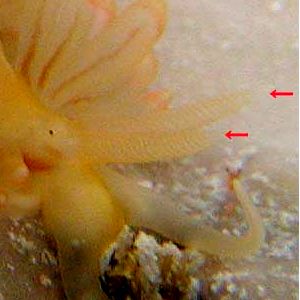
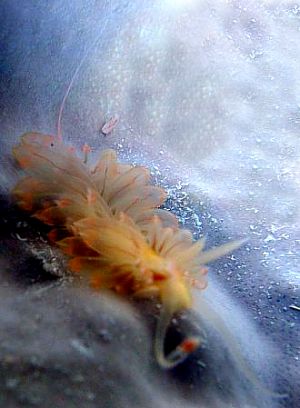
Dear Bill Rudman, Irina Roginskaya and Richard Willan,
Thank you for your comments on my animal. It's a very difficult to tell what my animal is because my photo is not good.
Rhinophores:
I have expanded a part of the photo. I hope that we can tell that the rhinophores is twisted or the rhinophores have a thin line.
Cerata:
I agree that it's not leaf-like. The cerata of my animal resembles the cerata of the animal identified as Berghia major at:
http://siolibrary.ucsd.edu/slugsite/phil/berghia.html. But the tip of an cerata of my animal is slightly sharp and is white.
About the color of the body of a my animal, I think that the second attached image might helpful. A photo of this is taken only with the camera's builtin flash unit.
Etc:
My animal resembles the animal of a photo in Mr.Ono's book. - Eubranchus sp. on page 159.
I also feel that it is not Burnaia helicochorda. But I want to apologize to Dr.Rudman because you have to say something about my animal with photos which the focus and color does not suit. So I have asked whether I can have the photograph of the animal in the local guide of Mable Island diving to send to you.
Best Regards,
Nishina Masayoshi
nishina@hpe15.wips.co.jp
Nishina, M., 2001 (Jul 2) Re: 'Aeolidia' helicochorda . [Message in] Sea Slug Forum. Australian Museum, Sydney. Available from http://www.seaslugforum.net/find/4687Note added 13 Jan 2003: This is almost certainly Facelina rhodopos. See Nishina Masayoshi's message.
Dear Nishina,
Thanks for the further information. I agree its not Burnaia helicochorda - but in the absence of a good photo it was an interesting thought. Thank you for your apology, but it is really not necessary. I want the Forum to be a place where we can all exchange thoughts and ideas. That is going to be very difficult if we are scared of offending each other. I know I am not always right, and when I am wrong I would like to think my colleagues, and friends, would tell me. So please don't ever feel bad if you don't agree with me. Just make sure you tell me.
As to what your animal is, I think we will need to look at its anatomy. In your new photo I can see that the oral tentacles are very long, like the posterior foot. And perhaps the rhinophores consist of rows of fine papillae or have very thin lamellae? It is a bit of a mystery.
Best wishes,
Bill Rudman
Further photos of mystery aeolid
July 2, 2001
From: Nishina Masayoshi
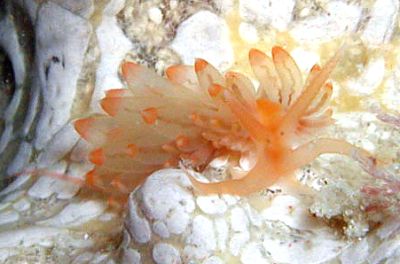
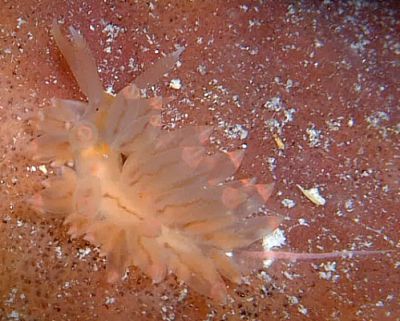
Dear Dr.Rudman
These photographs were offered by Miss Miki Tanaka who is the guide at The Sipadan Water Village Diving center at Mabul Is. Borneo, Malaysia.
I do hope these photographs are helpful.
Best Regards,
Nishina Masayoshi
nishina@hpe15.wips.co.jp
Nishina, M., 2001 (Jul 2) Further photos of mystery aeolid. [Message in] Sea Slug Forum. Australian Museum, Sydney. Available from http://www.seaslugforum.net/find/4696Note added 13 Jan 2003: This is almost certainly Facelina rhodopos. See Nishina Masayoshi's message.
Dear Nishina,
Please thank Miss Miki Tanaka for these photos, they certainly show the details of this animal. The only animal I know that looks anything like this is Michel Barrabes' photo from France of Berghia verrucicornis. Trinchese's original painting [as Berghia coerulescens], which you can see in my answer to Michel's message, also looks very similar. I guess it's unlikely that they are the same, but being shipped around in ballast water is not an impossible suggestion.
As I said before without an animal, we can only speculate.
Best wishes,
Bill Rudman
Re: 'Aeolidia' helicochorda
June 23, 2001
From: Richard Willan
Dear Bill,
Noticing your couple of recent messages on the Forum relating to "Aeolidia" helicochorda, I realised you had not caught up with Michael Miller's recent review of the New Zealand Aeolidiidae. A new genus, Burnaia, is created in that article for this species and there are other major changes to the taxonomy and nomenclature of the whole family.
In my opinion, the aeolid from Malaysia you have included on the Forum is not Burnaia helicochorda. Three characters are too disparate to call it that name. Firstly, the rhinophores of the Malaysian animal are much longer in proportion to the cerata and they have many lamellae. Secondly, the cerata are larger and not cylindrical; they actually seem to be inflated and/or compressed like those of Cyerce. Thirdly, the digestive diverticulum is much narrower. In addition, this species seems to lack the dark red horseshoe-shaped marking on its head that is very characteristic of B. helicochorda. Though it it impossible to be certain on this last point because the photo of the Malaysian animal does not show the head clearly.
REFERENCE:
Miller, M.C. (2001) Aeolid nudibranchs (Gastropoda: Opisthobranchia) of the family Aeolidiidae from New Zealand waters. Journal of Natural History, 35(5): 629-663.
Regards,
Richard
richard.willan@nt.gov.au
Willan, R.C., 2001 (Jun 23) Re: 'Aeolidia' helicochorda. [Message in] Sea Slug Forum. Australian Museum, Sydney. Available from http://www.seaslugforum.net/find/4651Note added 13 Jan 2003: This is almost certainly Facelina rhodopos. See Nishina Masayoshi's message.
Dear Richard,
Thanks for alerting me to Michael Miller's review. Michael pronised this review when he first described A. helicochorda so I wondered when it was to be published.
Concerning the identity of the animal from Malaysia, I find it a bit difficult to be quite as definite in my views as you apparently feel. The rhinophores do seem more slender but they are certainly do not appear to be any more lamellate than new South Wales animals. Concerning the shape of the cerata - they certainly seem cylindrical to me. As you say they are inflated, which is certainly different from in Michael's description where they are described as long and slender, much like in the photos at the top of the page from New South Wales. However the very animals in the photos were able to transform the shape of their cerata into much shorter inflated structures. Unfortunately I have been unable to photograph them in this state but I have drawings of them doing this, and as I say at the top of the page, when they are inflated like this there are distinctive concentric rings just below the tip, a bit like an earthworms annuli. The thickness of the digestive gland is also a function of feeding, starved animals having very narrow digestive gland ducts. Concerning the H marking on the head, it's just not possible to see in Nishina's photos, and for that matter you can't see it on my photos either.
I don't know whether Nishina's animal is Burnaia helicochorda or not, we would need to know more about its anatomy before we could say anything sensible, but I think it is worth making the suggestion at this stage.
Best wishes,
Bill Rudman
Aeolidia helicochorda? from Malaysia
June 21, 2001
From: Nishina Masayoshi
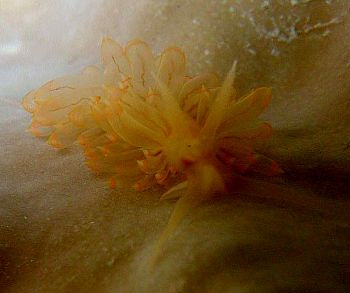
Dear Dr.Rudman,
Thank you very much for the answer for the my wife's question. We both understood your explanation.
This animal with beautiful cerata is found at Mabul Is. Borneo, Malaysia which we visited at the end of May, 2001. At first, I thought this animal is a kind of aeolid or maybe it's maybe Berghia major because of the shape and color of the cerata. This animal has pink long tail and twisted rhinophores. I didn't know that Berghia has twisted rhinophores. Another possibility is it's a kind of Janolus? but Janolus does not have such long oral tentacles as this animal, so is it a kind of Eubranchus? What is this?
The body and cerata color are more whitish and translucent then photo. I found this animal at night diving so the color is yellowish because of the strong flashlight that my wife used. Size about 2.5cm.
Other Data
2 June 2001, at house reef of Mabul Island. It was at about 6M depth where it was moving on a kind of fire coal surrounded by the rocky reef. Water Temp: 28-29C degree.
Sincerely yours,
Nishina Masayoshi,
nishina@hpe15.wips.co.jp
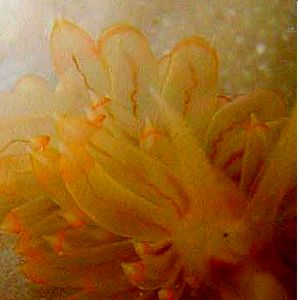
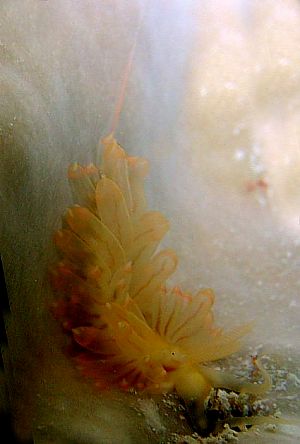
Note added 13 Jan 2003: This is almost certainly Facelina rhodopos. See Nishina Masayoshi's message.
Dear Nishina,
Your animal looks very much like Aeolidia helicochorda. If it is that species it is rather interesting because it has only been recorded from northern New Zealand and southeastern Australia previously. One difference are the rhinophores. You describe them as twisted. The photo is not that clear but they seem to be lamellate in your photo, quite like the shape in the photo at the top of the page of an Australian specimen. The other difference is that they lack the brown colour of the Australian animals. I would be grateful for any further information you have on the shape of the rhinophores.
If your animals is the same it would appear that it is a tropical species which occasionally visits southeastern Australia and New Zealand.
Best wishes,
Bill Rudman
